Figure 3. Mre11 complex integrity and DSB repair functions in rad50hook mutant cells.

A. Mre11 complex integrity in wild-type and rad50hook mutants assessed by co-immunoprecipitation and western blot with Rad50 or Mre11 antisera. Pre-immune antibodies (PI) were included as negative controls. B. Physical assessment of HO-induced sister chromatid recombination (SCR) as previously described (Hohl et al., 2011). Representative southern blots are shown. Right panel: Quantification of the 4.7 kb band specific for SCR relative to the total DNA. Error bars denote standard deviation from three independent experiments. C. Spontaneous ade2 heteroallelic mitotic recombination in ade2-n/ade2-l-Scel heterozygot diploids. White sectors (ADE2) within >200 red colonies (ade2) were scored. The average number of white sectors per colony for each genotype is given. Standard deviations correspond to 5-7 diploids analyzed. D. Cell survival (left panel) and NHEJ repair events (middle panel) after acute (2 hours) HO DSB induction at the MAT locus. Error prone NHEJ events detected in rad50 mutants were categorized as insertion, deletion or point mutation and are given in Figure S4A. Right panel: NHEJ repair kinetics for wild-type, rad50Δ and rad50-46. Cells were cultivated for 1.5, 3 or 5 hours in glucose medium following HO induction (2 hours) and repair was monitored by quantitative PCR with primers flanking the HO site. Error bars denote standard deviation from at least three independent experiments. E. Cell survival upon chronic HO induction. Repair junctions were analyzed and sequences are given in Figure S4B. Error bars denote standard deviation from at least three experiments.
